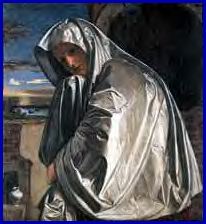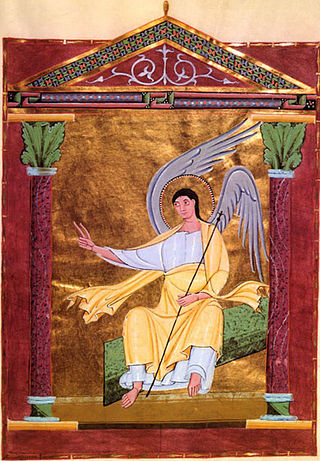
The empty tomb is the Christian tradition that the tomb of Jesus was found empty after his crucifixion. The canonical gospels each describe the visit of women to Jesus' tomb. Although Jesus' body had been laid out in the tomb after crucifixion and death, the tomb is found to be empty, the body gone, and the women are told by angels that he has risen.

John 20:15 is the 15th verse of the twentieth chapter of the Gospel of John in the New Testament of the Christian Bible. Mary Magdalene has returned to Jesus' tomb and found it empty. She does not know that Jesus has risen from death and they begin conversing without her realizing his identity.
John 20 is the twentieth chapter of the Gospel of John in the New Testament. It relates the story of Jesus' resurrection. It relates how Mary Magdalene went to the tomb of Jesus and found it empty. Jesus appears to her and speaks of his resurrection and dispatches Mary to tell the news to the disciples. Jesus then appears to his disciples. The events related in John 20 are described somewhat differently in Matthew 28, Mark 16, and Luke 24.

John 20:18 is the eighteenth verse of the twentieth chapter of the Gospel of John in the New Testament. It occurs after Jesus' resurrection and appearance to Mary Magdalene. In the previous verse Jesus has given Mary a message to deliver to his disciples, this verse describes how she delivers it.

John 20:14 is the fourteenth verse of the twentieth chapter of the Gospel of John in the New Testament of the Christian Bible. In this verse, Mary Magdalene has just finished speaking to the angels she found in Jesus's empty tomb. She then turns and sees the resurrected Jesus, but fails to recognize him. In the Gospel of John, this is the first moment anyone sees Jesus after his resurrection.
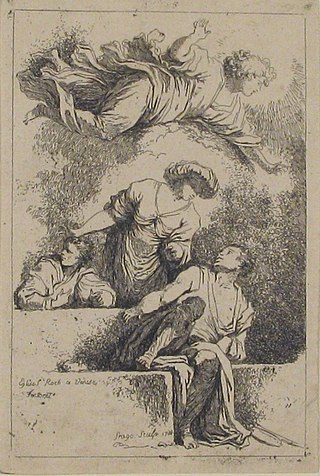
John 20:10 is the tenth verse of the twentieth chapter of the Gospel of John. Peter and the Beloved Disciple have just finished examining the empty tomb of Jesus, and in this verse they return home.

John 20:9 is the ninth verse of the twentieth chapter of the Gospel of John in the Bible. Peter and the Beloved Disciple have been examining Jesus' empty tomb and the arrangement of the grave clothes. John 20:8 states that the Beloved Disciple looked in the tomb and believed, though there is conflict on what exactly he believed. John 20:9 seems to modify this statement but its exact meaning is also unclear.

John 20:8 is the eighth verse of the twentieth chapter of the Gospel of John in the New Testament of the Christian Bible. Peter and the Beloved Disciple are examining Jesus's empty tomb. Peter has been inside the tomb since John 20:6, while the Beloved Disciple had been examining it from outside. In this verse the Beloved Disciple enters the tomb.
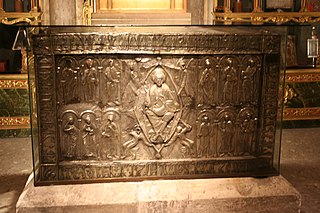
John 20:7 is the seventh verse of the twentieth chapter of the Gospel of John in the Bible. In this verse, Peter is standing in Jesus' empty tomb. The Beloved Disciple and perhaps Mary Magdalene are outside. This verse describes the arrangement of the grave clothes they see.

John 20:6 is the sixth verse of the twentieth chapter of the Gospel of John in the Bible. Peter and the Beloved Disciple have just arrived at the empty tomb of Jesus. The Beloved Disciple, who arrived slightly ahead of Peter, paused outside the empty tomb. In the verse, Peter enters the tomb upon his arrival.

John 20:5 is the fifth verse of the twentieth chapter of the Gospel of John in the Bible. The Beloved Disciple and Peter have travelled to the tomb of Jesus to investigate Mary Magdalene's report that the body of Jesus had disappeared. In this verse the Beloved Disciple arrives at the tomb and while he looks in, he does not enter it.

John 20:2 is the second verse of the twentieth chapter of the Gospel of John in the New Testament. Mary Magdalene has just discovered that the tomb of Jesus has been opened. In this verse she seeks out and tells this news to Peter and the "disciple whom Jesus loved".

John 20:3–4 are the third and fourth verses of the twentieth chapter of the Gospel of John in the New Testament. Peter and the Beloved Disciple have been informed by Mary Magdalene that Jesus' tomb has been opened and in these verses they depart for the tomb.

John 20:1 is the first verse of the twentieth chapter of the Gospel of John in the New Testament. John 20 covers the resurrection of Jesus after his crucifixion. In this verse Mary Magdalene visits Jesus' tomb and finds it opened.
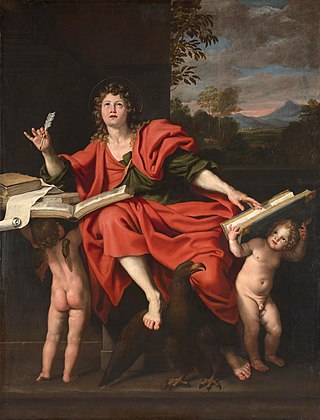
The phrase "the disciple whom Jesus loved" or, in John 20:2; "the other disciple whom Jesus loved", is used six times in the Gospel of John, but in no other New Testament accounts of Jesus. John 21:24 states that the Gospel of John is based on the written testimony of this disciple.

Luke 24 is the twenty-fourth and final chapter of the Gospel of Luke in the New Testament of the Christian Bible. The book containing this chapter is anonymous, but early Christian tradition uniformly affirmed that Luke the Evangelist composed this Gospel as well as the Acts of the Apostles. This chapter records the discovery of the resurrection of Jesus Christ, his appearances to his disciples and his ascension into heaven.

Matthew 28:1 is the first verse of the twenty-eighth chapter of the Gospel of Matthew in the New Testament. This verse opens the resurrection narrative as Mary Magdalene and "the other Mary" visit Jesus' tomb after the crucifixion.

Matthew 27:61 is the sixty-first verse of the twenty-seventh chapter of the Gospel of Matthew in the New Testament. This verse describes two women waiting by the Tomb of Jesus after the crucifixion.

Matthew 27:55–56 are the fifty-sixth and fifty-seventh verses of the twenty-seventh chapter of the Gospel of Matthew in the New Testament. The crucifixion and death of Jesus have just occurred, and these verses make note of a group of women who were present at that event.

In Eastern Orthodox Christian tradition the Myrrhbearers are the individuals mentioned in the New Testament who were directly involved in the burial or who discovered the empty tomb following the resurrection of Jesus. The term traditionally refers to the women who came with myrrh to the tomb of Christ early in the morning to find it empty. Also included are Joseph of Arimathea and Nicodemus, who took the body of Jesus down from the cross, anointed it with myrrh and aloes, wrapped it in clean linen, and placed it in a new tomb. In Western Christianity, the women at the tomb, the Three Marys or other variants are the terms normally used.
